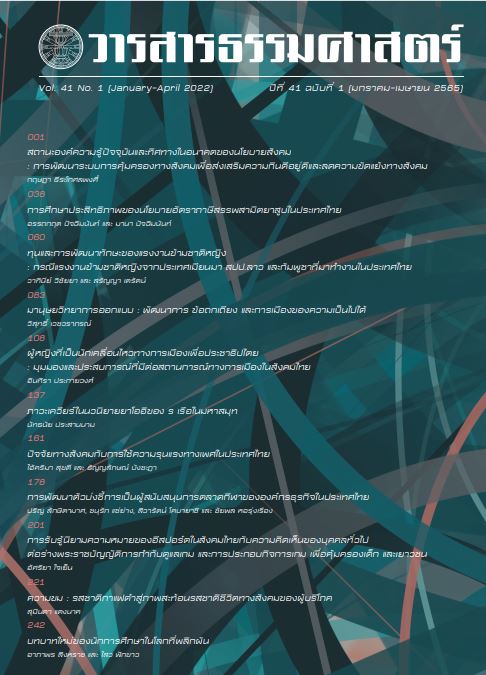Queerness in Ro Ruea Nai Mahasamut’s Yaoi Novels
Main Article Content
Abstract
This article aims at exploring the debate on diversification and polarization of genders and sexualities, within Thai society, through yaoi novels. Although the existing scholarship in Thai language claims its application of queer lens, the findings ironically
perpetuate the representation of gender diversity framed by patriarchal ideology. My argument is to revisit the delimited application of queer reading and unacknowledged literary convention in the academic discourse on Thai yaoi novels. Ro Ruea Nai
Mahasamut’s yaoi novels are employed in this pilot study. The research unravels queerness embedded in Thai yaoi novels through fluctuating genders and sexualities entailed by challenges against the Omegaverse convention derived from fan culture.
Furthermore, regarding the novels as queer texts, patriarchy is undermined and destabilized by the problematic father figures, the absence of fathers and the symbolically incestuous relationship between fathers and sons. The analysis should potentially subvert the heteronormative dominance, endorsing queerness as spirit of resistance through yaoi writings.
Article Details
References
กฤตพล สุธีภัทรกุล. (2563). การประกอบสร้างตัวละครชายรักชายในซีรีส์วาย. (วิทยานิพนธ์
ปริญญามหาบัณฑิต). สถาบันบัณฑิตพัฒนบริหารศาสตร์, กรุงเทพฯ.
กะเทยนิวส์. (2563). ฟินก็พอได้ แต่ซีรีส์วายก็อาจกลายเป็นปัญหากับ LGBT เสียเอง. สืบค้น
ตุลาคม 2563, จาก https://www.sanook.com/movie/94341/.
จเร สิงหโกวินท์. (2560). ถอดผ้าขายร่างในละครสาววาย. ใน นฤพนธ์ ด้วงวิเศษ (บรรณาธิการ),
เมื่อร่างกลายเป็นเพศ: อ านาจเสรีนิยมใหม่ของเพศวิถีในสังคมไทย (น. 150-186).
กรุงเทพฯ: ศูนย์มานุษยวิทยาสิรินธร (องค์การมหาชน).
ชลิตา สุนันทาภรณ์. (2561). รักที่จะรักหลากหลาย: นักเขียนรางวัลซีไรต์กับนิยาย Y ของเธอ.
สืบค้น 1 มกราคม 2564, จาก https://thepotential.org/voice-of-new-gen/jidanunleungpiansamut-interview/.
ณัฐธนนท์ ศุขถุงทอง และภูวิน บุณยะเวชชีวิน. (2562). ซีรีส์วาย: ข้อพิจารณาเบื้องต้นทางสถิติ.
International Journal of East Asian Studies, 23(2), 360-383.
ณัฐกานต์ อมาตยกุล. (2560). จิดานันท์ เหลืองเพียรสมุท: สาว Y ผู้ได้ซีไรต์. สืบค้น 1 มกราคม 2564, จาก https://themomentum.co/jidanun-leungpiansamut-sea-write/.
นฤพนธ์ ด้วงวิเศษ. (2560). ชายหนุ่มเป็นวัตถุทางเพศและการปรับขบวนเพศวิถีในละครชายรักชาย. ใน นฤพนธ์ ด้วงวิเศษ (บรรณาธิการ), เมื่อร่างกลายเป็นเพศ: อำนาจเสรีนิยมใหม่ของเพศวิถีในสังคมไทย (น. 188-223). กรุงเทพฯ: ศูนย์มานุษยวิทยาสิรินธร (องค์การมหาชน).
นัทธนัย ประสานนาม. (2562). นวนิยายยาโออิของไทย: การศึกษาเชิงวิเคราะห์. วารสารวิชาการหอสมุดแห่งชาติ, 7(2), 16-34.
______ . (2563). การเว้นระยะห่างทางเพศสถานะ: นวนิยายยาโออิของไทยในการเมืองเรื่องขนบ วรรณกรรมกับการตีความ. วารสารศาสตร์, 13(3), 160-187.
ปรเมศวร์ ตั้งสถาพร. (2563). กดซ้ำ กดซ้อน: บรรทัดฐานความรักเพศเดียวกันกับซีรีส์วาย. สืบค้น 17 ตุลาคม 2563, จาก https://spectrumth.com/2020/02/04.
ร เรือในมหาสมุท. (2560). ชายใดเล่าจะแซ่บเท่าแฟนเก่าแม่. กรุงเทพฯ: เอเวอร์วาย.
______. (2561). ตีแผ่ชีวิตสายซึน. กรุงเทพฯ: เอเวอร์วาย.
______ . (2561). เฟื่องนคร. กรุงเทพฯ: เอเวอร์วาย.
______. (2562). Good Night, My Last Mistake ราตรีสวัสดิ์รักแท้. กรุงเทพฯ: เอเวอร์วาย.
______. (2562). จีบเยลลี่แถมฟรีคนดื้อ. กรุงเทพฯ: เอเวอร์วาย.
สุชัญญา วงค์เวสช์, วรวรรธน์ ศรียาภัย, บุญยงค์ เกศเทศ และศานติ ภักดีคำ. (2563). เพศวิถีของตัวละครในนวนิยายหลากหลายความนิยมทางเพศรส. วิวิธวรรณสาร, 4(2), 27-58.
สุภาวรัชต์ วัฒนทัพ. (2556). ภาพแทนคนรักเพศเดียวกันในนิยายวายจากสื่ออินเทอร์เน็ต. (วิทยานิพนธ์ปริญญามหาบัณฑิต), มหาวิทยาลัยธรรมศาสตร์, กรุงเทพฯ.
อนุชา พิมศักดิ์. (2562). ภาพแทนเกย์ไทยในนวนิยายวายเรื่อง “เดือนเกี้ยวเดือน”: การผลิตซ้ำอุดมการณ์ทางการเมืองเรื่องเพศในสังคมไทย. วารสารมนุษย์กับสังคม, 4(2), 111-126.
อนุชา พิมศักดิ์. (2563). อัตลักษณ์ชายรักชายและการรื้อสร้างในนวนิยายวัยรุ่นแนววาย. (วิทยานิพนธ์ปริญญาดุษฎีบัณฑิต), มหาวิทยาลัยมหาสารคาม, มหาสารคาม.
อรวรรณ วิชญวรรณกุล. (2559). ผู้หญิงกับการสร้างนวนิยายชายรักชาย. (วิทยานิพนธ์ปริญญามหาบัณฑิต), มหาวิทยาลัยธรรมศาสตร์, กรุงเทพฯ.
Allan, J. A. (2020). Men, masculinities, and popular romance. Oxford and New York: Routledge.
Busse, K. (2013). Pon Farr, Mpreg, Bonds, and the rise of the Omegaverse. In A. Jamison (Ed.), Fic: Why fanfiction is taking over the world (pp. 288–294). Dallas, TX: BenBella.
Butler, J. (2006). Gender trouble: Feminism and the subversion of identity. New York: Routledge.
Chou, D. (2010). Exploring the meaning of yaoi in Taiwan for female readers: From the perspective of gender. Intercultural Communication Studies, XIX(1), 78-90.
Galbraith, P. (2009). The otaku encyclopedia. Tokyo: Kodansha International.
Hall, D. E. (2003). Queer theories. Basingstoke: Palgrave Macmillan.
Jackson, P. A. (2000) . An explosion of Thai identities: Global queering and reimagining queer theory. Culture, Health & Sexuality, 2(4), 405-424.
Murphy, B. M. (2017) . Key concepts in contemporary popular fiction. Edinburgh: Edinburgh University Press.
Nagaike, K. & Aoyama, T. (2015). What is Japanese “BL Studies?”: A historical and
analytical overview. In. McLelland et al. (Eds.), Boys Love manga and
beyond: History, culture, and community in Japan (pp. 119-140). Jackson,
MS: University Press of Mississippi.
Pagliassotti, D., Nagaike, K. & McHarry, M. (2013). Editorial: Boys’ Love manga special section. Journal of Graphic Novels and Comics, 4(1), 1-8.
Pease, B. (2000). Recreating men: Postmodern masculinity politics. London: Sage.
Pham, A. P. (2021). What it means to love a man: The evolution of the Boys’ Love industry in Thailand. Southeast Asian Media Studies Journal, 3(2), 107-126.
Prasannam, N. (2019). Yaoi phenomenon in Thailand and the fan/industry interaction. Plaridel: A Philippine Journal of Communication, Media, and Society, 16(2), 62-89.
Radway, J. (1991). Reading the romance: Women, patriarchy, and popular literature. Chapel Hill and London: The University of North Carolina Press.
Ramsdell, K. (2012). Romance fiction: A guide to the genre (2nd ed.). Santa Barbara, CA: Libraries Unlimited.
Suzuki, K. (2015). What can we learn from Japanese professional BL writers?: A sociological analysis of yaoi/BL terminology and classifications. In M. McLelland et al. (Eds.), Boys Love manga and beyond: History, culture, and community in Japan (pp. 93-118 ). Jackson, MS: University Press of Mississippi.
Turner, S. D. (2018). Interdisciplinary approaches to yaoi manga: A review. Journal of Graphic Novels and Comics, 9(5), 458-472.
Wood, A. (2013). Boys' Love anime and queer desires in convergence culture: transnational fandom, censorship and resistance. Journal of Graphic Novels and Comics, 4(1), 44-63.
Xu, Y. & Yang, L. (2 0 1 3 ) . Forbidden love: incest, generational conflict, and the erotics of power in Chinese BL fiction. Journal of Graphic Novels and Comics, 4(1), 30–43.

